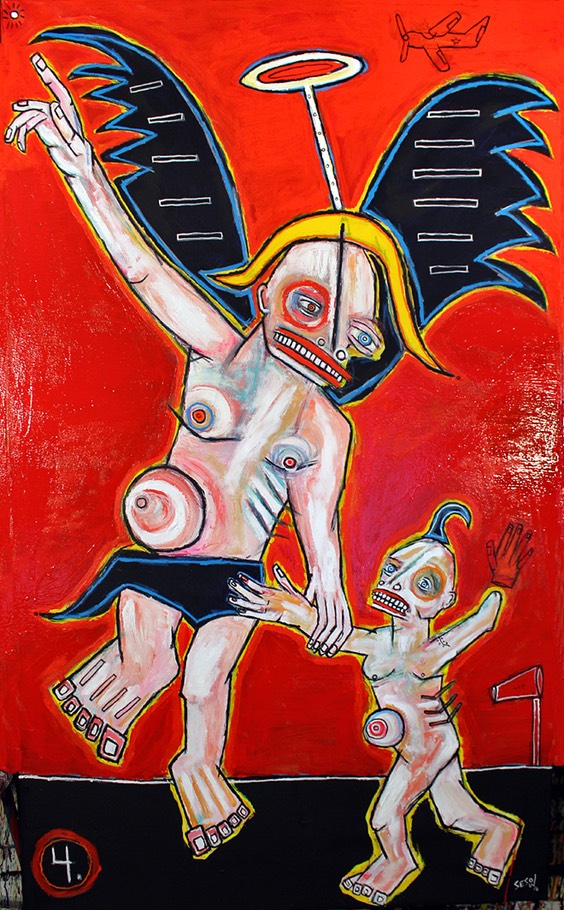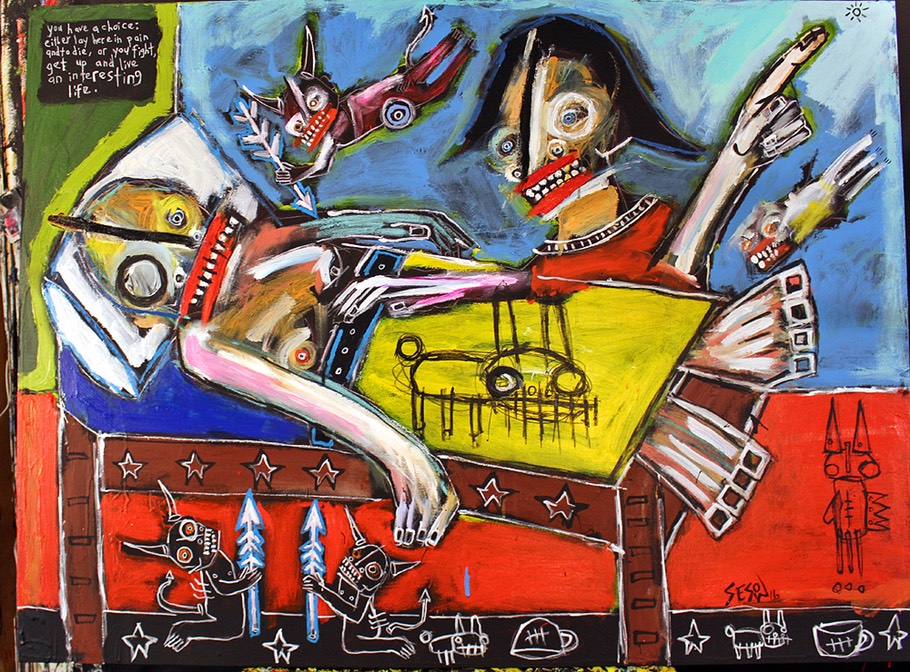In September, I visited the American Visionary Art Museum (AVAM) in Baltimore, a space devoted to artists who create outside the boundaries of formal art education or institutional validation. The museum defines “visionary” artists as self-taught makers who feel compelled to create. At AVAM, many of the artists are creating in response to trauma, loss, or profound personal transformation. Their work is not a pursuit of beauty for its own sake but an act of survival and meaning-making.
Among these artists, Matt Sesow stands out as a vivid example of how art can become both a record of injury and a tool for recovery. Sesow’s paintings are bold and emotionally charged, often rendered in bright primary colors, jagged lines, and thick swaths of acrylic. His style conveys the psychic disarray of trauma portrayed through images that are simultaneously familiar and unfamiliar.
Sesow’s story begins with an accident that might easily have ended his life. At age eight, while playing a game of spud in a Nebraska field, he threw a ball into the air and called out the number four unaware that a small propeller plane was gliding in for a landing, its engines off. The propeller struck his left arm, severing it below the elbow. After multiple surgeries and a long recovery, Sesow returned to daily life with one hand and an experience that would shape everything he later created.
He describes painting as the “cure to the emotional pain” that followed. Decades later, that pain remains a central subject in his work, not as a wound to be hidden but as the foundation for artistic identity. Influences like Salvador Dalí and Pablo Picasso gave Sesow early permission to distort the body and fracture perspective, while later inspirations such as Willem de Kooning’s abstraction and Jean-Michel Basquiat’s neo-expressionism, modeled how raw emotion and personal iconography could coexist in a single canvas. These styles suit his subject matter: the surreal, dissociative qualities of medical trauma and how it fractures the perception of and relationship to the physical body.
The idea of art as therapy is often sentimentalized, but in Sesow’s case it feels exacting and unsentimental. His paintings present the raw psychological labor of trauma recovery. His 2016/17 AVAM exhibition “Shock + Awe” made that process explicit, including a series of autobiographical works depicting his childhood injury and subsequent surgeries. Two pieces from that show, “Guardian Angel” and “A Choice,” illustrate Sesow’s emotional processing and meaning making around injury and adjustment.

Guardian Angel sets the scene against a crimson sky and a desolate airfield. A small airplane hovers above; in the foreground, a massive angel dominates the frame, reaching for a child while pointing toward a small yellow orb that appears part sun, part portal. The angel’s wings are black, its halo bright white, its role ambiguous.
The child’s severed hand, painted red, fades into the background. The number 4 appears in the bottom corner, referencing the moment of the game that set the accident in motion. “When I was hit by the plane,” Sesow says in the documentary Join Hands, “there was a guardian angel there. But was it to protect me or to push me in front of the plane?”
That question captures a tension many trauma survivors know well. The uneasy awareness of how close things came to ending differently. After a life-threatening injury, survival can feel both miraculous and arbitrary. People often wonder if they somehow “cheated death,” and what that second chance is supposed to mean. For some, it brings gratitude; for others, guilt or confusion. Living in that ambiguous space can shape how someone understands their own life. Sesow’s work sits squarely in that tension, translating it into color and form rather than trying to resolve it.

While Guardian Angel revisits the accident, A Choice confronts its aftermath. The painting depicts Sesow on an operating table. His reattached hand, briefly preserved by surgeons, has become infected; the procedure now requires its removal. The composition is dense, almost chaotic in an eruption of color and text. A Choice introduces recurring figures that populate much of Sesow’s later work.
Among them are two symbols that appear frequently in his paintings: the “trauma cup,” which holds his overflowing emotions, and a small cartoonish rabbit. Though Sesow doesn’t explicitly define the rabbit’s meaning, the symbol resonates: rabbits represent adaptability, quickness, and the ability to navigate challenges. All qualities Sesow demonstrated in his physical recovery and psychological survival. Hovering over the amputation site is another ambiguous creature, part angel and part demon, an arrow extending from its hand toward the boundary between the warm reds and blacks of living tissue and the cold blue-gray of the severed limb.
In the top left corner, a line of text transcribes what Sesow imagines the angel told him: “You have a choice. Either lay here in pain and die, or you fight, get up, and live an interesting life.”
Sesow has used the word conquer when talking about his injury and his art. His paintings show that process in action by turning pain into something he can face directly and master on his own terms. The energy in his work feels like rebellion. By painting through his strongest emotions, he refuses to be defined by the injury and instead claims authority over it. He chose the fight, and through his art, he has built exactly what the angel promised—an interesting life.
Excerpts from interviews with Matt Sesow came from the following sources:
https://www.artsupplies.co.uk/blog/qa-with-artist-matt-sesow/

.jpg)
.jpg)

.jpg)